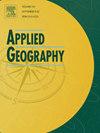基于情境化地理加权神经网络(CGWNN)模型的城市高分辨率人口密度制图
IF 5.4
2区 地球科学
Q1 GEOGRAPHY
引用次数: 0
摘要
高分辨率网格人口数据在各个领域都是至关重要的。由于影响因素与人口密度之间的非线性关系,在不同的土地利用地块内,人口密度在不同的网格上存在空间差异,因此估算异质城市人口面临挑战。本文利用多源数据,建立了一种情境化地理加权神经网络(CGWNN)模型,用于估算北京市100 × 100m网格上的人口密度。该模型将人工神经网络与地理加权回归相结合,以解释近似网格之间相似的非线性关联。通过将地块级土地利用作为可变权重,它还考虑了位于不同土地利用地块的邻近网格之间的上下文变化关联。与忽略上述关联和广泛使用的人口数据集的其他模型相比,我们的CGWNN模型获得了更高的精度(R2 = 0.85)。最重要的三个变量是离最近的学校、餐馆和汽车服务的距离,它们都与人口密度呈负相关。此外,夜间人造光强度(ALAN)与不同地区的人口密度呈正相关和负相关,表明ALAN的增加并不一定意味着城市地区的人口密度更高。我们的建模方法显示了准确的人口估计的希望,这可以扩展到更大的区域,使各个领域受益。本文章由计算机程序翻译,如有差异,请以英文原文为准。
High-resolution population density mapping in urban areas using a contextualized geographically weighted neural network (CGWNN) model
High-resolution gridded population data are crucial for various fields. Estimating heterogeneous urban populations presents challenges due to nonlinear relationships between influential factors and population density, which vary spatially across grids within different land-use parcels. This study developed a Contextualized Geographically Weighted Neural Network (CGWNN) model to estimate population density on 100 × 100m grid cells in Beijing, China, using multi-source data. This model integrated the artificial neural network with geographically weighted regression to account for nonlinear associations that are similar across proximate grids. By incorporating parcel-level land uses as variable weights, it also considered contextually varying associations across proximate grids located in different land-use parcels. Our CGWNN model achieved superior accuracy (R2 = 0.85) compared to other models that ignored the aforementioned associations and widely used population datasets. The top three important variables were the distances to the nearest school, restaurant, and auto service, all negatively associated with population density. Additionally, the intensity of artificial light at night (ALAN) exhibited both positive and negative associations with population density in different regions, suggesting that the increased ALAN did not necessarily indicate higher population density in urban areas. Our modeling approach shows promise for accurate population estimation, which could be extended to larger areas, benefiting various fields.
求助全文
通过发布文献求助,成功后即可免费获取论文全文。
去求助
来源期刊

Applied Geography
GEOGRAPHY-
CiteScore
8.00
自引率
2.00%
发文量
134
期刊介绍:
Applied Geography is a journal devoted to the publication of research which utilizes geographic approaches (human, physical, nature-society and GIScience) to resolve human problems that have a spatial dimension. These problems may be related to the assessment, management and allocation of the world physical and/or human resources. The underlying rationale of the journal is that only through a clear understanding of the relevant societal, physical, and coupled natural-humans systems can we resolve such problems. Papers are invited on any theme involving the application of geographical theory and methodology in the resolution of human problems.
 求助内容:
求助内容: 应助结果提醒方式:
应助结果提醒方式:


